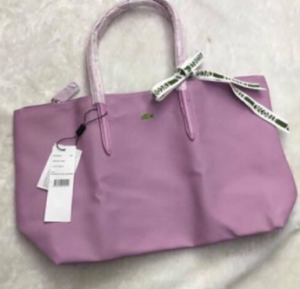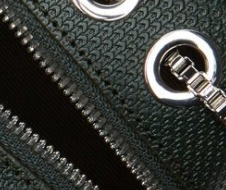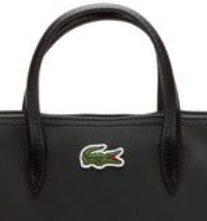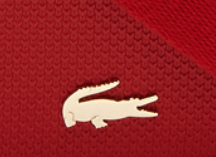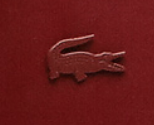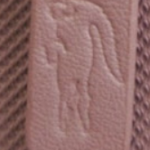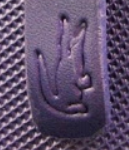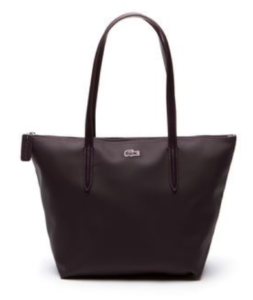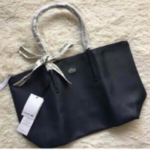Updated March 15, 2024
There are a lot of fake Lacoste bags out there, so before you buy, here’s a simple step-by-step process for detecting whether the women’s Lacoste tote bag or purse you are buying is a genuine Lacoste or a cheap fake. For other tips on avoiding fake Lacoste products, see my page on detecting counterfeit Lacoste. For information on reporting fake Lacoste items, go to Lacoste’s brand protection page.
It’s important not to be fooled by superficial packaging features. Packaging is cheap, so the makers of fake Lacoste bags go to a lot of trouble to replicate Lacoste packaging while skimping on the more expensive manufacturing processes. For example, here’s a picture of a “replica” Lacoste bag currently for sale on the internet:
That packing and the labels look pretty authentic, don’t they? Therefore, you need to focus on other elements.
Where Did You Buy The Bag?
Start with where you are buying the bag. If you bought the bag from a street seller or from eBay, you can be almost certain that it’s a fake. Lacoste bags are only sold at Lacoste’s own stores or at certified retailers. You can determine if a store is an approved seller by checking it out on Lacoste’s website.
Is The Quality Of The Construction And Materials High?
Lacoste bags can be made of canvas, PVC or leather, but they all share one thing in common: their construction and materials are of high quality. A common fault of fake bags is inferior stitching. Genuine Lacoste bags have small, even, solid stitching. Uneven stitching or loose threads is an indication of a counterfeit bag. A good place to check the stitching is inside the bag, since the manufacturers of fakes often skimp on the non-visible stitching. If you see uneven stitching around the inside of the bag, or bunching of the lining around the rim, you can be pretty sure you have a counterfeit bag.
Genuine Lacoste bags will also have quality zippers, fastenings, and handle attachments that are neatly and securely sewn in. An example from a genuine Lacoste bag is shown below
The zipper of a Genuine Lacoste bag will run right up to the edge of the bag opening. The zips of most replicas will stop short of the opening. The loop handle on a Lacoste tote bag is made with a garter material under the leather. This makes the strap less stiff and easy to bend. Most replicas will omit the garter center, so their handles are much stiffer and harder to bend.
Is The Lacoste Logo Correct?
All Lacoste bags have a genuine Lacoste logo that is either printed on the bag (canvas) or attached (leather and PVC). Genuine Lacoste logos are of high quality, with defined lines. Fakes also tend to have shapes that are not correct. An example of a genuine traditional logo on a leather bag is shown below
Lacoste bags can also have monochrome logos. An example of a monochrome logo on a canvas bag is shown below
Sometimes, as shown below, the monochrome logo matches the bag’s material.
For other examples of legitimate Lacoste logos, see my page on the Lacoste Crocodile Logo.
Some bags have embossed logos. In general, a genuine embossed Lacoste log will be distinct, but shallowly embossed. See below for an example:
Replica embossed logos tend to be deeper, as you can see below:
Check The Tag
An authentic Lacoste bag will come with a tag listing details about the bag including the materials, model and size.
Does The Bag Reflect Lacoste’s Design Sensibility?
If you browse through the Lacoste website, you will soon become familiar with Lacoste’s design sensibility. Lacoste tote bags are all narrower at the bottom than the top, and have large U shaped straps. The logo on the bags is usually at the top and centered. The leather bags don’t come in outrageous colors, and the purses also have very traditional designs. After you have looked at a few examples, you will have a good idea of whether Laooste would have designed the bag you are looking at buying. Here’s an example of a Genuine Lacoste bag:
I hope these tips are helpful, and that they will prevent you spending your hard-earned dollars on phony merchandise. Remember, the counterfeiters work hard to fool you, so don’t be taken in by superficial packaging touches, such as the ones shown on the fake bag pictured below:
General Tips on Identifying Counterfeit Designer Bags
In addition to these specific indicators relevant to Lacoste, here are some more general tips on identifying counterfeit designer bags:
- Authenticity Cards or Certificates: Some designer bags come with authenticity cards or certificates, which contain unique codes or holograms to authenticate the bag’s origin.
- Branding Details: It’s important to check the logos, fonts, and engravings for consistency and accuracy. Misalignments or misspellings can indicate a counterfeit.
- Hardware Quality: Genuine designer bags use high-quality hardware that should be branded, function smoothly, and be durable. Check for flaking, cracking, or peeling of the hardware.
- Stitching Quality: The stitching on authentic designer bags should be impeccable, with evenly spaced and aligned stitches. Any discrepancy in stitch count or color can be a red flag.
- Bag Size and Proportions: Verify the bag’s measurements against the official brand specifications to ensure it matches the correct size, shape, and proportions.
- Interior Layout: The interior of a genuine designer bag should be well-organized and consistent with the brand’s design. Any discrepancies in the interior layout or quality can indicate a fake.
- Serial Numbers: Designer bags often have unique serial numbers or codes. Research the brand’s serial number format and verify if the number on the bag aligns with the brand’s standards.
- Purchase Source: To avoid buying a fake, it’s recommended to buy directly from authorized retailers or brand boutiques. Be cautious of significantly lower prices and ensure secure payment methods are used.
- Hardware Consistency: Ensure that the hardware color matches the logo color on the inside of the handbag. For specific brands like Chanel, certain measurements and placements of logos and hardware are standard and can be verified for authenticity
Other Resources
